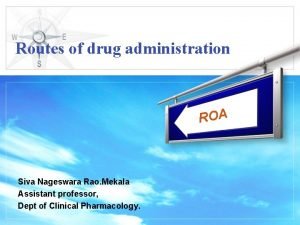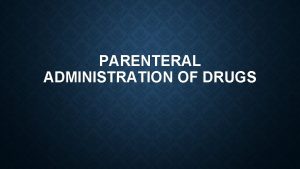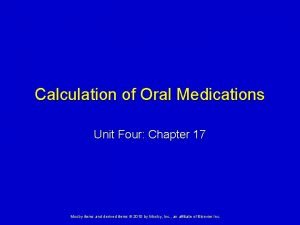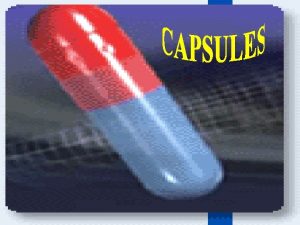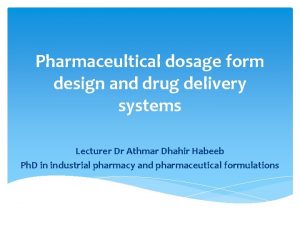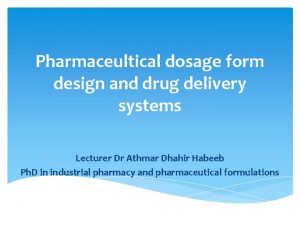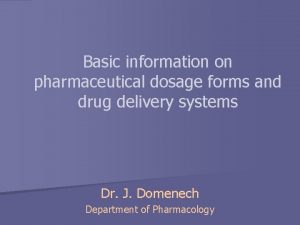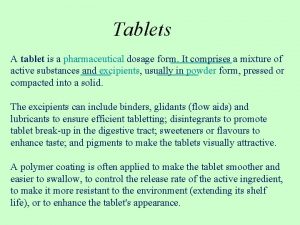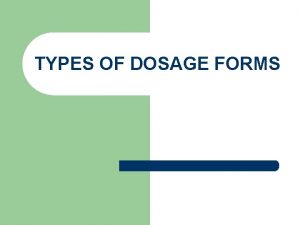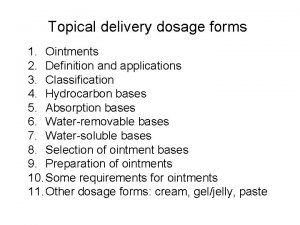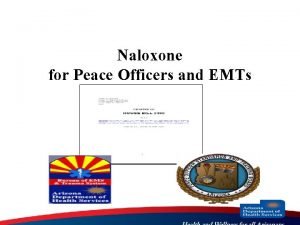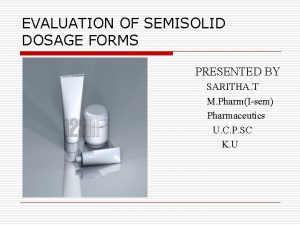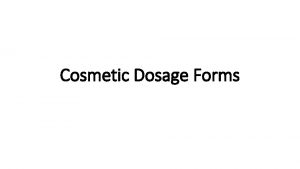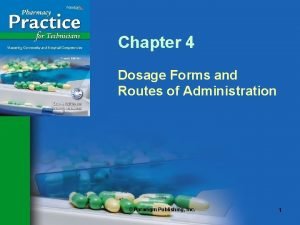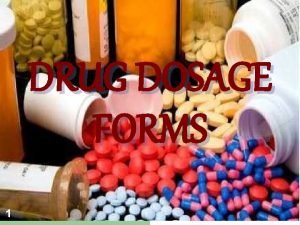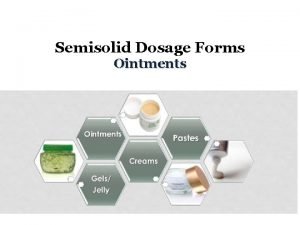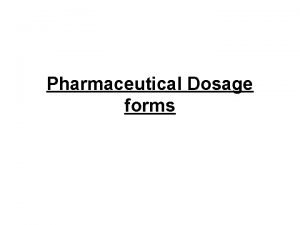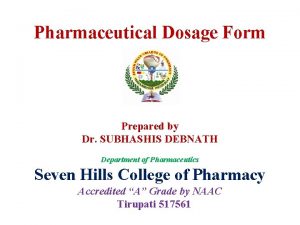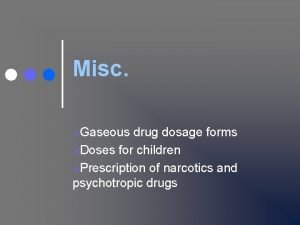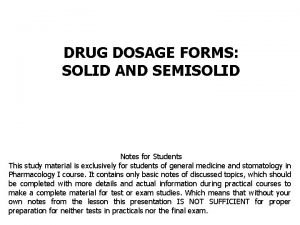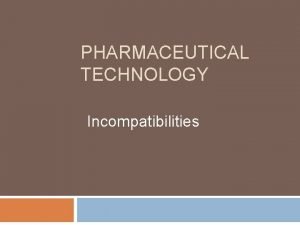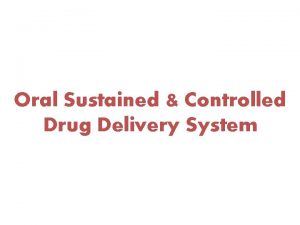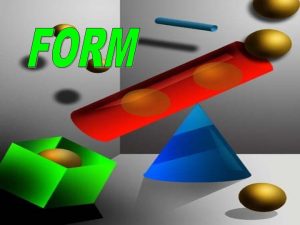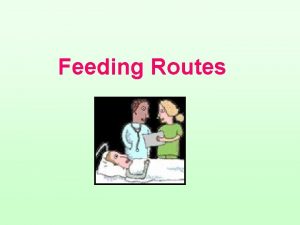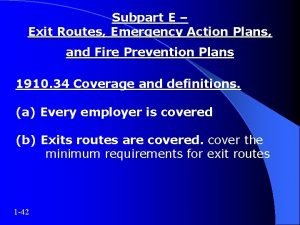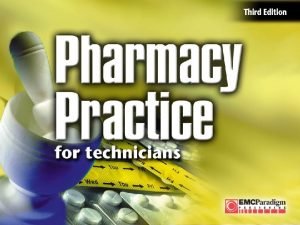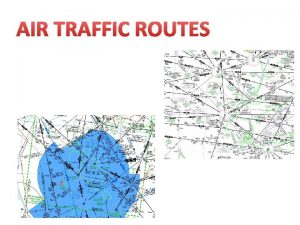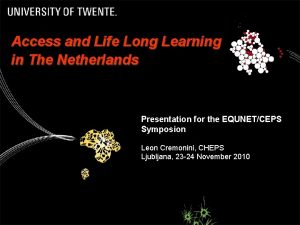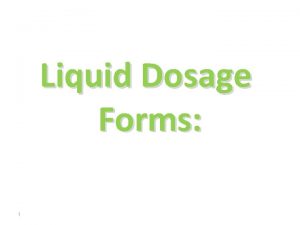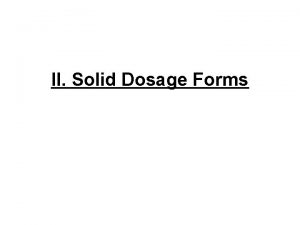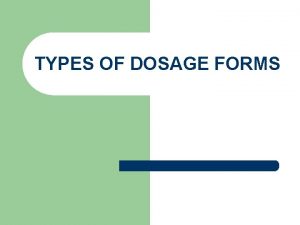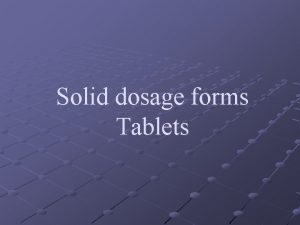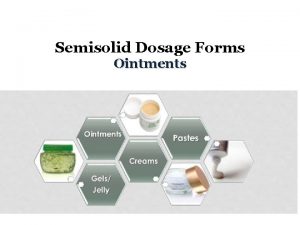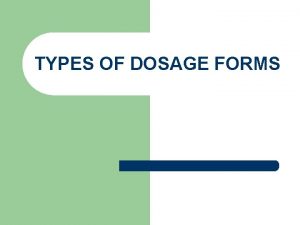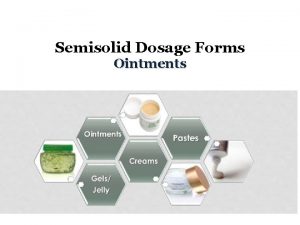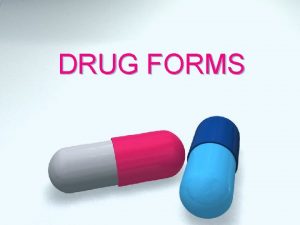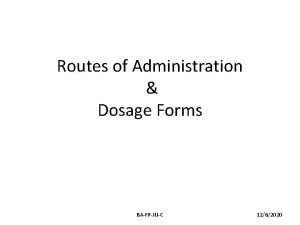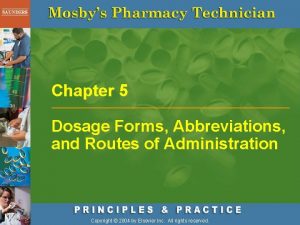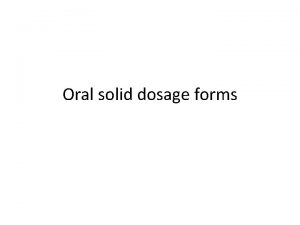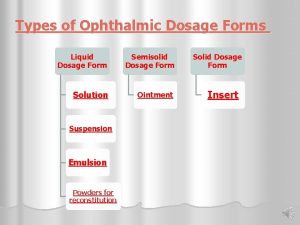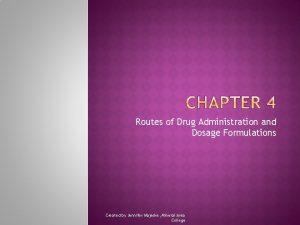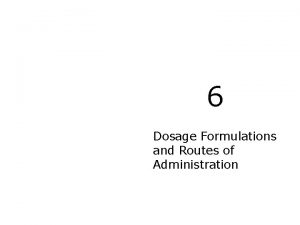Dosage Forms and Routes of Administration Chapter 5
























































- Slides: 56

Dosage Forms and Routes of Administration Chapter 5 Copyright © 2016, Elsevier Inc. All rights reserved. 1

Lesson 5. 1 Drug Classification and Dosage 1. 2. 3. List dangerous abbreviations and explain why they are on the “Do Not Use” list. Recognize the general classifications of medications and the related body systems. Identify various dosage formulations and give examples of each. Copyright © 2016, Elsevier Inc. All rights reserved. 2

Introduction To become proficient, a technician must interpret prescribers’ orders correctly � Many doctors’ handwriting is referred to as “chicken scratch”; it is the responsibility of the pharmacy to interpret and clarify orders if necessary � Many abbreviations used in prescribing medication look very much alike � Copyright © 2016, Elsevier Inc. All rights reserved. 3

Where Did Pharmacy Abbreviations Originate? � Pharmacy and medical terminology comes from the Latin and Greek languages ➢ � Latin and Greek serve as universal languages in medicine Because pharmacy began in Europe, most abbreviations have their origins in a foreign language Copyright © 2016, Elsevier Inc. All rights reserved. 4

Interpreting Prescribers’ Orders It is very important for the pharmacy staff to interpret prescribers’ orders correctly � When writing out the various abbreviations, be sure to write as neatly as possible because other technicians and pharmacists will be reading your handwriting � Technicians must learn all the dosage forms and abbreviations to decipher prescribers’ orders � Copyright © 2016, Elsevier Inc. All rights reserved. 5

“Do Not Use” List � Drug errors that have occurred as a result of the misinterpretation of medication orders led to the creation of the “Do Not Use” list The list outlines the most common misread abbreviations ➢ These abbreviations should be avoided ➢ Copyright © 2016, Elsevier Inc. All rights reserved. 6

Dosing Instructions Dosing times are abbreviated on prescriptions � Many pharmacy computers are programmed to accept these abbreviations � Copyright © 2016, Elsevier Inc. All rights reserved. 7

Classification of Medications � Drugs can be classified into different groups based on: Pharmacology ➢ Intent of use ➢ Route of administration ➢ Mechanism of action ➢ Body system affected ➢ Copyright © 2016, Elsevier Inc. All rights reserved. 8

Different Types of Drugs Available to Consumers � Three classifications describe the drugs available to consumers: Over-the-counter (OTC) drugs ➢ Legend drugs ➢ Behind-the-counter (BTC) drugs ➢ Copyright © 2016, Elsevier Inc. All rights reserved. 9

Dosage Forms � Dosage form: The means by which a drug is available for use For example, the form may be a tablet, but there are many types of tablets ➢ Tablets can be scored or unscored and coated or uncoated ➢ The dosage form is determined primarily by which form makes the drug most effective � Manufacturers prepare certain medications with the ability to release the active ingredient over an extended period � Copyright © 2016, Elsevier Inc. All rights reserved. 10

Unscored and Scored Tablets Copyright © 2016, Elsevier Inc. All rights reserved. 11

Dosage Forms � Three major categories of dosage forms: Solids ➢ Liquids ➢ Semisolids ➢ Copyright © 2016, Elsevier Inc. All rights reserved. 12

Solids Can be contained in various packages and administered by almost all routes except parenterally � Most tablets contain fillers (inert substances that have no active ingredient), sugar coatings, and certain additives � Copyright © 2016, Elsevier Inc. All rights reserved. 13

Tablets � � � Made to be administered sublingually (SL) or vaginally Some may be scored, which allows the dosage to be cut in half May be enteric coated to protect the drug through the acidic environment of the stomach or to delay release of the drug Chewable tablets are convenient for children and people who have difficulty swallowing Extended-release types are made to control the amount of drug distributed over a set time Copyright © 2016, Elsevier Inc. All rights reserved. 14

Types of Tablets Copyright © 2016, Elsevier Inc. All rights reserved. 15

Tablets and Caplets � � � The most common type of tablet contains some type of filler Fillers are composed of inert substances (no active ingredient) that fill space or cover the tablet (sugar coatings) Coating improves the taste and covers unpleasant odors Caplets are smooth sided and easier to swallow Many medications have extended-release forms and regular forms Copyright © 2016, Elsevier Inc. All rights reserved. 16

Capsules Can have either a hard or soft outer shell � Hard capsules: Composed of sugar, gelatin, and water � Pulvule: A type of capsule that is shaped differently for identification purposes � Spansule: Capsule that can be pulled apart to sprinkle the medication onto food for children � Soft-gelatin capsules (gel caps): Cannot be pulled apart; often hold medications in liquid form � Copyright © 2016, Elsevier Inc. All rights reserved. 17

Types of Capsules Copyright © 2016, Elsevier Inc. All rights reserved. 18

Lozenges/Troches and Biomaterials � Troches: A type of tablet that is meant to dissolve in the mouth ➢ � Flat, larger than normal-sized tablets; have a chalky consistency Biomaterials: Polymers (long chains of hydrocarbons) that combine with or encapsulate a drug Can be capsules, tablets, or implants ➢ Drug can be activated by p. H or solubility and released over a period of 12 hours to several years ➢ Copyright © 2016, Elsevier Inc. All rights reserved. 19

Implants A special type of capsule can be implanted under the skin and left in place for up to 5 years � Contraceptives containing progestin are implanted � Medication is released in a stair-step method � Copyright © 2016, Elsevier Inc. All rights reserved. 20

Transdermal Patches Transdermal patches: Solid pieces of material that hold a specific amount of medication to be released into the skin over time � Easily administered and eliminate the possibility of an upset stomach � Uses � For angina: Nitroglycerin ➢ For chronic pain: Duragesic ➢ For motion sickness: Scopolamine ➢ Copyright © 2016, Elsevier Inc. All rights reserved. 21

Liquids Composed of various solutions � Can be administered by all routes � Syrups: Sugar-based solutions in which medication has been dissolved in them; they improve the taste of the drug � ➢ Tend to be thicker than water Copyright © 2016, Elsevier Inc. All rights reserved. 22

Elixirs and Sprays � Elixirs: Contain dissolved medication in either an alcohol base or a (hydroalcoholic) base Alcohol usually covers up the bad taste of the drug ➢ Elixirs have the same consistency as water ➢ � Sprays: Composed of various bases, such as alcohol or water, in a pump-type dispenser ➢ Nitroglycerin translingual spray is used under the tongue for relief of anginal pain Copyright © 2016, Elsevier Inc. All rights reserved. 23

Inhalants and Aerosols � Inhalants: Available in a variety of forms, but all must be easily inhaled into the lungs ➢ � � Common devices available OTC are vaporizers and humidifiers Respiratory therapists use nebulizers to give breathing treatments to hospital patients Patients can also be taught to use nebulizers at home Anesthetics: Inhaled solutions administered by an anesthesiologist during surgery Metered dose inhalers (MDIs): Dispense a specific amount of drug with each puff Copyright © 2016, Elsevier Inc. All rights reserved. 24

Emulsions and Suspensions � Emulsion: A mixture of water and oil bound together by an emulsifier ➢ � Many different types of emulsifiers are used Suspension: A liquid in which very small, solid particles suspended in the base solution Can be used orally by children and older adults ➢ Should have a “Shake well” sticker and an expiration date ➢ Copyright © 2016, Elsevier Inc. All rights reserved. 25

Enemas � Enemas might be administered for one of two reasons: ➢ Retention or evacuation They can be used to deliver medication to the body, bypassing the stomach for absorption � Most common use is to evacuate the lower intestine to prepare for surgeries or for women in labor � Copyright © 2016, Elsevier Inc. All rights reserved. 26

Semisolids Contain both liquids and solids � Are meant for topical application � Creams: Medication in a base that is part oil and part water; for topical use � Lotions: Thinner than creams because the base contains more water � Copyright © 2016, Elsevier Inc. All rights reserved. 27

Semisolids � Ointments: Medication in a glycol or oil base ➢ Cover the skin’s surface and keep out moisture Gels: Medication in a viscous (thick) liquid that easily penetrates the skin � Pastes: Contain a smaller amount of liquid base than solids; able to absorb skin secretions, unlike other topical agents � Copyright © 2016, Elsevier Inc. All rights reserved. 28

Suppositories and Powders � Suppositories can be used both rectally and vaginally Rectal suppositories bypass the stomach, which is important if the patient has nausea and vomiting ➢ Vaginal suppositories are used mainly to treat vaginal infections ➢ � Powders are solids, yet they can be packaged in some forms that allow them to be sprayed, similar to liquid dosage forms ➢ One of the main uses is to reduce the amount of moisture in an area Copyright © 2016, Elsevier Inc. All rights reserved. 29

Lesson 5. 2 Routes of Administration, and Drug Storage and Use 4. 5. 6. 7. 8. Identify various routes of administration and give examples of each. Explain the difference between pharmacokinetics and pharmacodynamics. List and explain the absorption, distribution, metabolism, elimination, and bioavailability of drugs in the body. Define first-pass metabolism and explain why it is important in drug delivery. Define half-life and describe factors that influence it. Copyright © 2016, Elsevier Inc. All rights reserved. 30

Lesson 5. 2 Routes of Administration, and Drug Storage and Use 9. 10. 11. 12. 13. Define the bioequivalence of drugs and its relationship to the Orange Book. Describe why excipients (additives) are necessary in the production of medications. List three different common drugs and their storage requirements. List the segments that make up medical terms and provide examples of each. Recognize and interpret common abbreviations as they apply to dosage forms and routes of administration. Copyright © 2016, Elsevier Inc. All rights reserved. 31

Routes of Administration Oral (by mouth) medications are very convenient, do not need to be measured, are less expensive, systemic, and safe � Do not work as quickly as parenterals � Some drugs cannot be taken orally because they are not as effective � Copyright © 2016, Elsevier Inc. All rights reserved. 32

Sublingual and Buccal Drugs Nitroglycerin (NTG), which treats anginal attacks, is the most commonly used sublingual tablet � Buccal agents are placed between the gum and cheek, where the medication penetrates the mouth lining and then enters the bloodstream � Copyright © 2016, Elsevier Inc. All rights reserved. 33

Rectal Agents Rectal (PR) agents are used for a person who is vomiting and cannot take oral medications � To reduce inflammation, either ointments or creams can be used in addition to suppositories � Rectal agents usually work on a specific site and not systemically � They are uncomfortable and the actual amount of drug absorbed is hard to predict � Copyright © 2016, Elsevier Inc. All rights reserved. 34

Topical Drugs Effects range from systemic to localized (for rashes) � These agents can fight skin infections, inflammation, and block UV rays of the sun � Work at the site of action and systemically � Advantage: Easy application � Disadvantage: May cause a reaction � Copyright © 2016, Elsevier Inc. All rights reserved. 35

Parenteral: Intravenous, Intravenous Piggyback, Intramuscular, Subcutaneous Drugs � � The term parenteral is Greek in origin and means “side of intestine” or “outside of intestine” The most common parenteral medications are given IV, IM, or SC Very-small-gauge needles are used; the length depends on the injection site Parenteral drugs work within a few minutes ➢ � This is important for emergency situations, for those who are combative, or for those who are unable to swallow Disadvantage: Increased risk of infection Copyright © 2016, Elsevier Inc. All rights reserved. 36

Parenteral: Intravenous, Intravenous Piggyback, Intramuscular, Subcutaneous Drugs Injections are more expensive and require preparation and administration by trained personnel � Disadvantage: Once a drug is injected, there is little time to alter its course if an allergic reaction takes place or too much drug is given � Copyright © 2016, Elsevier Inc. All rights reserved. 37

Drugs for the Eye, Ear, and Nose Eye (ophthalmic) solutions are often used to treat ear (otic) conditions, but ear solutions cannot be used to treat eye conditions because the eye is sterile � Otic preparations are not necessarily sterile because they treat the ear canal and do not penetrate a sterile environment � Copyright © 2016, Elsevier Inc. All rights reserved. 38

Drugs for the Eye, Ear, and Nose � � All ophthalmics must be kept sterile Different types of agents are available for the eye, ear, and nose, including ointments, solutions, and suspensions ➢ � � � These dosage forms work on the specific site Most ear treatments are done to clear up infections or clean out earwax buildup Most nose (nasal) sprays are used to treat colds and allergies Eye treatments are for infections, inflammation, and glaucoma Copyright © 2016, Elsevier Inc. All rights reserved. 39

Inhalants � Inhalants (INH) are used to treat lung diseases ➢ � � Metered dose inhalers (MDIs) are used for asthma, bronchitis, or emphysema Corticosteroids are also available in MDIs for chronic conditions ➢ � � Dosage forms are limited but very effective if used properly Two types: Propellant and dry powder Most aerosols come in handheld units and are very convenient Disadvantage: Little if any of the drug is able to get into the lungs Copyright © 2016, Elsevier Inc. All rights reserved. 40

Injectables � Long-acting parenteral drugs are available that can be used in place of daily dosing ➢ They should never be given intravenously Copyright © 2016, Elsevier Inc. All rights reserved. 41

Miscellaneous Routes Miscellaneous routes include vaginal or urethral dosage forms: Suppositories, ointments, foams, and gels � They are used to treat infections and inflammation; vaginal foams are used as a contraceptive � Advantage: They bypass a systemic effect and affect a specific site � Disadvantage: They are not easily applied and are uncomfortable � Copyright © 2016, Elsevier Inc. All rights reserved. 42

Other Considerations: Form and Function � Dosage forms are created based on the results from many clinical trials that delve into the pharmacokinetics of the medication or the function of the drug in experiments Copyright © 2016, Elsevier Inc. All rights reserved. 43

Pharmacokinetics vs. Pharmacodynamics � Pharmacokinetics: Encompasses the many different components of the actions of the body on a drug Levels of the drug throughout the blood and tissues ➢ Absorption of the drug throughout the body ➢ Overall distribution ➢ Reaction of the drugs with other drugs ➢ Patient compliance ➢ Life of the drug (bioavailability, half-life, bioequivalence, and elimination) ➢ � Pharmacodynamics: The effects of the drug on the body Copyright © 2016, Elsevier Inc. All rights reserved. 44

Absorption Medications are made to get through natural body barriers, such as the skin, stomach, intestines, blood-brain barrier, and other membranous tissues � How well the drug passes through these barriers (absorption) is the one factor that determines its ultimate effectiveness � Copyright © 2016, Elsevier Inc. All rights reserved. 45

Distribution After a medication is absorbed, it is distributed throughout the body via the bloodstream into tissues, membranes and, ultimately, organs � Distribution of a drug is not necessarily equal throughout the body � Most drugs bind to blood proteins to some degree � Copyright © 2016, Elsevier Inc. All rights reserved. 46

Metabolism Most metabolism takes place in the liver. � Metabolism changes the chemical structure of the original drug � Different influences can alter metabolism: Age, gender, genetics, diet, and other chemicals digested � Copyright © 2016, Elsevier Inc. All rights reserved. 47

First-Pass Effect For some drugs, the dose travels to the liver, and part of it is metabolized before the drug has a chance to be distributed throughout the body � This first-pass effect lowers a drug’s bioavailability � First-pass drugs are given in larger doses � Copyright © 2016, Elsevier Inc. All rights reserved. 48

Elimination � Elimination is the last phase of a drug’s life in the body � Drugs can be excreted in many ways: Via the kidneys, feces, exhalation, sweat glands, and breast milk ➢ Urination and bowel movements are the most common methods of excretion Copyright © 2016, Elsevier Inc. All rights reserved. 49

Bioavailability � The rate at which a drug makes it to its destination and becomes available to the site of action for which it is intended (bioavailability) � Different drugs clear in different ways and at different times ➢ Many drugs travel to the liver before they have a chance to be absorbed into the whole system (first -pass effect) Copyright © 2016, Elsevier Inc. All rights reserved. 50

Half-Life The amount of time it takes the body to break down and excrete one half of a drug � An important factor in the creation of drugs because it tells the manufacturer how long it takes the body to rid itself of the drug � Copyright © 2016, Elsevier Inc. All rights reserved. 51

Bioequivalence The comparison between drugs either from different manufacturers or in the same company but from different batches of a drug � Generic drug manufacturers strive to achieve bioequivalence to compete with brand name manufacturers � Copyright © 2016, Elsevier Inc. All rights reserved. 52

Use of Excipients � All medications are prepared with additives (excipients) ➢ Coloring, flavorings, fillers, and preservatives Some patients may be allergic or intolerant to these additives � Other types of excipients: Increase the dispersion of a drug once it reaches the intestines, or release the medication over a longer period � Copyright © 2016, Elsevier Inc. All rights reserved. 53

Packaging and Storage Requirements All types of dosage forms must be approved by the FDA � Medications are packaged according to manufacturers’ specifications to ensure the effectiveness and shelf life of the drug � All medications have a package insert that describes the storage and stability of the drug � Copyright © 2016, Elsevier Inc. All rights reserved. 54

Medical Terminology Medical terms have their origins in Greek and Latin � There are four segments, or word parts: � Prefix: Before combing form (peri-) ➢ Suffix: After combining form (-itis) ➢ Root word (heart) ➢ Combining form (cardio) ➢ Copyright © 2016, Elsevier Inc. All rights reserved. 55

Questions? Copyright © 2016, Elsevier Inc. All rights reserved. 56
 What are the different routes of drug administration
What are the different routes of drug administration What are the different routes of drug administration
What are the different routes of drug administration Penrose drain
Penrose drain Chapter 17 dosage calculation and medication administration
Chapter 17 dosage calculation and medication administration Punch method capsule
Punch method capsule Rate limiting steps in drug absorption
Rate limiting steps in drug absorption Dosage forms and drug delivery systems
Dosage forms and drug delivery systems Throat paints definition in pharmacy
Throat paints definition in pharmacy Dosage forms and drug delivery systems
Dosage forms and drug delivery systems Advantages and disadvantages of dosage forms pdf
Advantages and disadvantages of dosage forms pdf Enema dosage form
Enema dosage form Water washable base
Water washable base Naloxone dose
Naloxone dose Evaluation parameters of semi solid dosage forms
Evaluation parameters of semi solid dosage forms Cosmetic dosage forms
Cosmetic dosage forms Topical dosage forms
Topical dosage forms Evaluation of paste
Evaluation of paste Types of dose
Types of dose Semi solid dosage forms definition
Semi solid dosage forms definition Examples of unit dosage form
Examples of unit dosage form Manufacturing of pharmaceutical of semisolid dosage forms
Manufacturing of pharmaceutical of semisolid dosage forms Yunitron
Yunitron Types of solid dosage forms
Types of solid dosage forms Gaseous dosage form
Gaseous dosage form Advantages of semi solid dosage form
Advantages of semi solid dosage form Therapeutic incompatibility is due to
Therapeutic incompatibility is due to Sustained release vs extended release
Sustained release vs extended release I am not short form
I am not short form Strong and weak forms of auxiliary verbs
Strong and weak forms of auxiliary verbs Central.route persuasion
Central.route persuasion Cognitively based attitude
Cognitively based attitude Linux operation and administration chapter 8
Linux operation and administration chapter 8 Why are related forms more agreeable than unrelated forms
Why are related forms more agreeable than unrelated forms Why are related forms more agreeable than unrelated forms
Why are related forms more agreeable than unrelated forms Why are related forms more agreeable than unrelated forms?
Why are related forms more agreeable than unrelated forms? Where the vikings come from
Where the vikings come from Trade routes in the 1500s
Trade routes in the 1500s Tower enroute control
Tower enroute control Routes for learning route map
Routes for learning route map Trade routes 1500
Trade routes 1500 Trade routes in the 1500s
Trade routes in the 1500s Routes of feeding
Routes of feeding Transport routes in sap
Transport routes in sap Dutch exploration routes
Dutch exploration routes 1910 subpart e
1910 subpart e Ming dynasty trade routes
Ming dynasty trade routes Lux express group
Lux express group Jacques cartier legacy
Jacques cartier legacy Constantinople trade routes
Constantinople trade routes Parenteral route
Parenteral route Hostile surveillance detection
Hostile surveillance detection Dutch exploration routes
Dutch exploration routes Preferred ifr routes beginning with a fix
Preferred ifr routes beginning with a fix Kennis learning routes llp
Kennis learning routes llp Bird migration routes
Bird migration routes Seafaring traders chapter 3 section 3
Seafaring traders chapter 3 section 3 Trigon tamu
Trigon tamu
